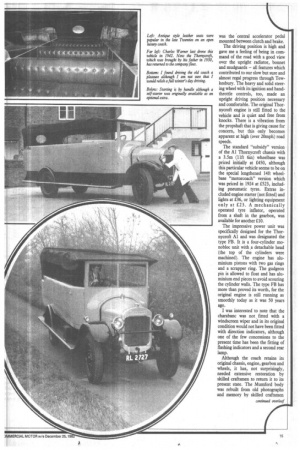Swing low, sweet charabanc
Page 14

Page 15

Page 16

If you've noticed an error in this article please click here to report it so we can fix it.
Our esteemed Hors eless-carriage for• the Conveyance of Passenger correspondent, Mr Noel Millier, has been pursuing his peregrinations a the wheel of this most superior mode of motorised transportation. H4 fmds it to be a quite delightful machine, if a shade exhilerating at 1! boneshaking miles within the hour
IN 1930 H. F. Warner added a fouryear-old Mumford bodied char-abane to his coach fleet operating from Twyning Green, near Tewkesbury, Gloucestershire. It saw service carrying to coastal resorts on Sunday school outings, before ("Don't you know there's a war on?") in 1939 the needs of both the business and the country changed and the vehicle was converted into a lorry.
Forty years later the vehicle was restored in its original livery, and it now has pride of place in the fleet of Warner Fairfax Tours.
When I visited Tewkesbury and met Charles Warner, the son of H. F. Warner and the present owner of the charabanc, he told me that last time he drove the vehicle was in 1942 during its lorry era. As we prepared to put the 56-year-old vehicle through its paces, he donned a white milking coat — a white coat and cap was the usual garb of the chara driver of the Thirties.
The charabanc was based on the popular Thornycroft Al 30cwt chassis introduced in 1924. It is powered by a four-cylinder petrol engine with 95mm (33/4in) bore by 127mm (5in) stroke driven through a single steel-plate clutch and a fourspeed constant-mesh gearbox. The Al chassis was designed for War Office lorry requirements — any civilian buyer buying a lorry to WO specifications was entitled to an annual subsidy of £40, although the longer passenger adaptation of the chassis meant that the original buyer of the charabanc would have received no such subsidy.
The four-cylinder Thomycroft engine was normally rated at 25hp but, according to CM September 2, 1924, will develop 40hp if required. Normal engine speed is 1,500rpm, giving, by 1924 standards, good performance; by today's it is hardly startling. The charabanc is normally capable of 6mph in first gear, 9mph in second, 16 in third and 25 in fourth. Braking efficiency with both band and foot brakes, operating on a drum on the rear wheels only, is well matched to the performance. However, it did cause problems when the vehicle was used as a lorry and was fully laden at maximum speed.
From the point of view of passengers, the Miunford body was roomy and comfortable. Seating was on five comfortably padded longitudinal bench seats, each accommodating four passengers. With the exception of the front seat, entry to the body is by separate doors on the nearside. For enthusiastic and nim ble passengers climbing in is no problem. For the elderly or disabled, entry, particularly to the last seat but one, could be a problem.
On a fine day the charabanc offers comfort — and plenty of legroom. On a fine day with the hood down the ride would have been very pleasant, but in early December — with no heating or sidescreens — it was decidedly chilly. However, with the body heat of 20 passengers, including one sitting on the driver's right, the vehicle would certainly promote togetherness and could be very cosy.
Since no separate starter is fitted to the vehicle, starting demands a swing. A driver stalling the vehicle at the traffic lights today would very definitely not be appreciated by following motorists, but in the Twenties and Thirties the problem would have been less acute.
-In Tewkesbury the vehicle drew admiring glances from the young, plus a steady stream of nostalgic reminiscences from the surprising number of passers-by who fondly remember Sunday school outings in such a vehicle. These must have been much more of an adventure than in the modern and relatively draught-proof coach of today.
When my opportunity to drive the vehicle came, I have to admit I approached the task with some tre pidation; the previous coach I ha( driven was much larger and longer but in many respects far less awe inspiring. However, the act of driv ing proved a pleasure. The elutei was light and predictable and dm gear change slow but smooth. Ono the revs had died down, completini upward and downward changes fel like sliding a knife into a lump o firm Cheddar cheese.
The steering was heavy but ver positive — the old coach gave a no unjustified impression of inde structability and sat like a rock ol the road. The ride was firm but sur prisingly good from the basicalI commercial chassis. One featur that did require some getting used t was the central accelerator pedal mounted between clutch and brake.
The driving position is high and gave me a feeling of being in command of the road with a good view over the upright radiator, bonnet and mudguards — all features which contributed to our slow but sure and almost regal progress through Tewkesbury. The heavy and solid steering wheel with its ignition and handthrottle controls, too, made an upright driving position necessary and comfortable. The original Thornycroft engine is still fitted to the vehicle and is quiet and five from knocks. There is a vibration from the propshaft that is giving cause for concern, but this only becomes apparent at high (over 20mph) road speeds.
The standard "subsidy" version of the Al Thomycroft chassis with a 3.5m (lift 6in) wheelbase was priced initially at £450, although this particular vehicle seems to be on the special lengthened 14ft wheelbase "motorcoach" version which was priced in 1924 at £523, including pneumatic tyres. Extras included engine starter (not fitted) and lights at £36, or lighting equipment only at £23. A mechanically operated tyre inflator, operated from a shaft in the gearbox, was available for another £10.
The impressive power unit was specifically designed for the Thornycroft Al and was designated the type FB. It is a four-cylinder monobloc unit with a detachable head (the top of the cylinders were machined). The engine has aluminium pistons with two gas rings and a scrapper ring. The gudgeon pin is allowed to float and has aluminium end pieces to avoid scouring the cylinder walls. The type FB has more than proved its worth, for the original engine is still running as smoothly today as it was 50 years ago.
I was interested to note that the charabanc was not fitted with a windscreen wiper and in its original condition would not have been fitted with direction indicators, although one of the few concessions to the present time has been the fitting of flashing indicators and a second rear lamp.
Although the coach retains its original chassis, engine, gearbox and wheels, it has, not surprisingly, needed extensive restoration by skilled craftsmen to return it to its present state. The Mumford body was rebuilt from old photographs and memory by skilled craftsmen who used as many original techniques as possible. A long-wheelbase version was shown as an 18seater Dragon coach at the seventh Commercial Motor Exhibition at Olympia in 1925 (price of admission: two shillings except Saturdays when it was one shilling, now known as five pea).
One of its more unusual features was the use of a two-piece propellor shaft with an intermediate universal joint. A flexible disc mounting for the steady bearing carrying the rear end of the front part of the propellor shaft is fitted.
The coach, with original Cornish registration, serves as reminder of days gone by. Although the petrol engine and gearbox are remarkably up to date, it is probably in the area of braking and passenger comfort that the most progress has been made in the past 50 years.
Talking to Charles Warner it was interesting to compare coaches and the earning potential of running charabancs like the Thornycroft in the early Thirties with the costs and income of the high-specification integral luxury coach of today.
Drivers' wages, the cost of fuel and vehicles are all in the same proportion as when the Thornycroft joined the fleet. Only the rates obtained for the work have not kept pace with the passing years, which is probably why it is more difficult now to establish a coach business and still be in business in 62 years time than it was when H. F. Warner started his now strong and well established family business. Above: The sign writing on the back of the boot and the hackney carriage plate match the original photograph in the Warner records.
Above right: A minimum of instruments and controls are fitted to the Thornycroft. The central accelerator pedal is a point w remember in emergency situations.
Right: Offside and nearside views of the four-cylinder side-valve engine developed for the Al range in 1924.
Below: The Thornycroft Al chassis was originally introduced in 1924 as a basis for a War Office subsidy lorry although the long-wheelbase adaptation was specifically designed with coaches and buses in mind.


































